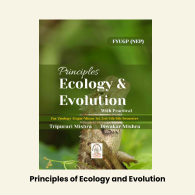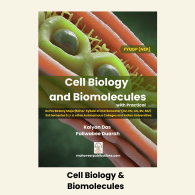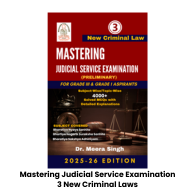

jog (yoga)
Inhouse product
-
Rs308.00
Rs350.00 -
Rs288.00
Rs300.00 -
Rs238.00
Rs280.00 -
Rs476.00
Rs595.00 -
Rs374.00
Rs425.00 -
Rs175.50
Rs195.00
Reviews & Ratings
Jog (Yoga)" by Dr. Daisy Rani Chutia is a comprehensive and student-friendly textbook designed as per the FYUGP NEP syllabus of Dibrugarh University for Value Added Course in the 2nd Semester of Arts, Science, and Commerce streams. Published by Mahaveer Publications, this book introduces the ancient practice of yoga in an academic context, blending theoretical foundations with practical applications to enhance physical, mental, and emotional well-being among students.
It covers the fundamental concepts, history, principles, and importance of yoga in modern life, along with guidance on basic postures (asanas), breathing techniques (pranayama), and relaxation methods. Aligned with the New Education Policy’s holistic approach, the book promotes self-awareness, stress management, and overall wellness through an integrative curriculum.
UNIT I: Introduction to Yoga (5 Hours)
1.1 Meaning and Definitions of Yoga
What is Yoga? Yoga, derived from the Sanskrit root "yuj," means "to unite" or "to join." It represents the union of individual consciousness with universal consciousness, encompassing physical, mental, and spiritual dimensions.
Classical Definitions:
- Patanjali's Definition: "Yoga is the cessation of fluctuations of the mind" (Yogash chitta-vritti-nirodhah)
- Bhagavad Gita: "Yoga is equanimity of mind" (Samatvam yoga uchyate)
- Modern Definition: A comprehensive system combining physical postures, breathing techniques, meditation, and ethical principles
1.2 History of Yoga
Ancient Period (Before 2nd Century BCE):
- Origins in the Indus Valley Civilization
- Vedic period references in Rig Veda
- Upanishadic developments
Classical Period (2nd Century BCE - 2nd Century CE):
- Patanjali's Yoga Sutras
- Bhagavad Gita's contribution
- Systematization of yoga philosophy
Post-Classical Period (2nd Century CE onwards):
- Hatha Yoga development
- Tantric influences
- Modern revival and global spread
1.3 Importance of Yoga as Art, Science, and Philosophy
Yoga as Art:
- Creative expression through asanas
- Aesthetic beauty in practice
- Individual interpretation and style
Yoga as Science:
- Systematic methodology
- Measurable benefits
- Research-based validation
Yoga as Philosophy:
- Ethical guidelines (Yamas and Niyamas)
- Spiritual growth principles
- Life philosophy integration
UNIT II: Philosophical Perspective of Yoga (5 Hours)
2.1 Yoga in Bhagavad Gita
Four Paths of Yoga:
Karma Yoga (Path of Action):
- Selfless service without attachment to results
- Duty-bound action (Dharma)
- Practical application in daily life
Jnana Yoga (Path of Knowledge):
- Self-inquiry and wisdom
- Understanding the true nature of reality
- Discrimination between eternal and temporary
Bhakti Yoga (Path of Devotion):
- Love and surrender to the Divine
- Emotional purification
- Nine forms of devotion (Nava Vidha Bhakti)
Raja Yoga (Royal Path):
- Mental discipline and meditation
- Eight-limbed path of Patanjali
- Systematic spiritual development
2.2 The Yoga Sutras - General Significance in Life
Structure of Yoga Sutras:
- Pada 1: Samadhi (Concentration)
- Pada 2: Sadhana (Practice)
- Pada 3: Vibhuti (Supernatural Powers)
- Pada 4: Kaivalya (Liberation)
Practical Applications:
- Ethical living guidelines
- Mental training techniques
- Spiritual development roadmap
- Stress management principles
UNIT III: Yoga Practices for Health & Wellness (4 Hours)
3.1 Asana Classification and Effects
Standing Asanas:
- Tadasana (Mountain Pose): Improves posture, balance
- Vrikshasana (Tree Pose): Enhances concentration, leg strength
- Utthita Trikonasana (Extended Triangle): Stretches spine, improves digestion
Sitting Asanas:
- Sukhasana (Easy Pose): Calms mind, improves posture
- Padmasana (Lotus Pose): Enhances meditation, flexibility
- Vajrasana (Thunderbolt Pose): Aids digestion, strengthens legs
3.2 Pranayama Types and Effects
Basic Techniques:
- Natural breathing awareness
- Deep abdominal breathing
- Chest and clavicular breathing
Advanced Techniques:
- Anulom Vilom (Alternate Nostril Breathing)
- Kapalbhati (Skull Shining Breath)
- Bhramari (Bee Breath)
3.3 Kriya, Mudra, and Bandha
Kriyas (Cleansing Practices):
- Neti (Nasal cleansing)
- Dhauti (Digestive tract cleansing)
- Basti (Colon cleansing)
Mudras (Hand Gestures):
- Gyan Mudra: Enhances concentration
- Prana Mudra: Increases life force
- Apana Mudra: Aids elimination
Bandhas (Energy Locks):
- Mula Bandha: Pelvic floor engagement
- Uddiyana Bandha: Abdominal lock
- Jalandhara Bandha: Throat lock
3.4 Dhyana and Its Significance
Meditation Fundamentals:
- Preparation and posture
- Breath awareness
- Concentration techniques
- Mindfulness practices
Benefits:
- Stress reduction
- Improved focus
- Emotional regulation
- Spiritual growth
UNIT IV: Allied Knowledge on Yoga (1 Hour)
4.1 Yoga vs Physical Exercise
Differences:
- Holistic vs. purely physical approach
- Mind-body integration vs. muscle building
- Spiritual dimension vs. competitive nature
- Gentle vs. intense practice
4.2 Yogic Diet
Principles:
- Sattvic (pure), Rajasic (stimulating), Tamasic (dull) foods
- Moderation and mindful eating
- Seasonal and local food choices
- Ethical considerations
4.3 Yoga Education Institutions
In India:
- Kaivalyadhama, Lonavla
- Bihar School of Yoga
- Rishikesh yoga centers
- University yoga departments
Abroad:
- International yoga organizations
- Certification programs
- Research institutions
PRACTICAL CONTENT (1 Credit - 30 Hours)
Section 1: Suryanamaskara (12 Counts)
Complete Sun Salutation Sequence:
Positions 1-12:
- Pranamasana (Prayer Pose) - Center alignment
- Hastauttanasana (Raised Arms Pose) - Backward bend
- Uttanasana (Standing Forward Bend) - Forward fold
- Ashwa Sanchalanasana (Equestrian Pose) - Low lunge
- Dandasana (Stick Pose) - Plank position
- Ashtanga Namaskara (Eight-Limbed Salutation) - Knees-chest-chin
- Bhujangasana (Cobra Pose) - Chest opening
- Adho Mukha Svanasana (Downward Dog) - Inverted V
- Ashwa Sanchalanasana (Equestrian Pose) - Low lunge
- Uttanasana (Standing Forward Bend) - Forward fold
- Hastauttanasana (Raised Arms Pose) - Backward bend
- Pranamasana (Prayer Pose) - Return to center
Benefits:
- Full body workout
- Cardiovascular health
- Flexibility improvement
- Mental clarity
Section 2: Asanas (Detailed Practice)
A) Standing Asanas:
Tadasana (Mountain Pose):
- Technique: Stand tall, feet together, arms by sides
- Benefits: Improves posture, strengthens legs
- Duration: 30 seconds to 1 minute
Vrikshasana (Tree Pose):
- Technique: Balance on one leg, other foot on inner thigh
- Benefits: Enhances balance, concentration
- Variations: Different arm positions
B) Sitting Asanas:
Sukhasana (Easy Pose):
- Technique: Cross-legged sitting, spine straight
- Benefits: Calms mind, improves posture
- Modifications: Use cushion or wall support
Vajrasana (Diamond Pose):
- Technique: Kneeling position, sitting on heels
- Benefits: Aids digestion, strengthens legs
- Duration: 5-10 minutes after meals
C) Lying Supine Position:
Shavasana (Corpse Pose):
- Technique: Lie flat, arms slightly away from body
- Benefits: Deep relaxation, stress relief
- Duration: 10-15 minutes
Setu Bandhasana (Bridge Pose):
- Technique: Lie on back, lift hips up
- Benefits: Strengthens back, opens chest
- Hold: 30 seconds to 1 minute
D) Lying Prone Position:
Bhujangasana (Cobra Pose):
- Technique: Lie face down, lift chest using back muscles
- Benefits: Strengthens spine, opens heart
- Variations: Low cobra, high cobra
Makarasana (Crocodile Pose):
- Technique: Lie face down, head resting on folded arms
- Benefits: Relaxes lower back, aids breathing
- Duration: 5-10 minutes
Section 3: Pranayama (Breathing Practices)
Basic Techniques:
Nadishodhana (Alternate Nostril Breathing):
- Technique: Use thumb and ring finger to control nostrils
- Benefits: Balances nervous system, improves concentration
- Duration: 5-10 rounds
Ujjayi (Victorious Breath):
- Technique: Slight constriction of throat, oceanic sound
- Benefits: Calms mind, generates internal heat
- Practice: Throughout asana practice
Sheetali and Sheetkari (Cooling Breaths):
- Technique: Inhale through curled tongue or teeth
- Benefits: Cools body, reduces stress
- Season: Best in summer
Section 4: Bandh & Mudra
Bandhas (Energy Locks):
Jalandhara Bandha (Throat Lock):
- Technique: Lower chin to chest, engage throat
- Benefits: Stimulates thyroid, conserves energy
- Practice: With pranayama
Uddiyana Bandha (Upward Flying Lock):
- Technique: Pull abdomen up and in on empty stomach
- Benefits: Strengthens core, improves digestion
- Precautions: Only on empty stomach
Mudras (Hand Gestures):
Moolabandha (Root Lock):
- Technique: Gentle contraction of pelvic floor
- Benefits: Strengthens core, improves stability
- Integration: With breathing and asanas
Yogamudra (Yoga Seal):
- Technique: Forward fold in cross-legged position
- Benefits: Calms mind, improves flexibility
- Duration: 1-3 minutes
Mahavedhamudra (Great Seal):
- Technique: Combination of bandhas with specific posture
- Benefits: Advanced energy work, spiritual development
- Level: Intermediate to advanced
Section 5: Dhyana and Forms
Meditation Techniques:
Preparation:
- Comfortable seated position
- Spine erect but not rigid
- Environment quiet and clean
- Regular practice time
Basic Meditation:
- Breath awareness
- Mantra repetition
- Visualization techniques
- Mindfulness practice
Progressive Stages:
- Dharana (Concentration)
- Dhyana (Meditation)
- Samadhi (Absorption)
ASSESSMENT METHODS
Modes of Assessment (In-Semester):
A) Unit Tests
- Format: Written examination
- Coverage: Theoretical concepts
- Duration: 1 hour
- Marks: 20% of total assessment
B) Class Seminar Presentation/Group Discussion
- Topics: Assigned yoga themes
- Duration: 15-20 minutes per presentation
- Assessment: Content, delivery, interaction
- Marks: 25% of total assessment
C) Seasonal Examination (Theory and Practical)
- Theory: Comprehensive written exam
- Practical: Demonstration of asanas, pranayama
- Duration: 2 hours theory + 1 hour practical
- Marks: 40% of total assessment
D) Attendance and Regularity
- Requirement: Minimum 75% attendance
- Assessment: Class participation, punctuality
- Marks: 10% of total assessment
E) Observation Record During Practical
- Format: Daily practice log
- Content: Personal observations, progress notes
- Assessment: Consistency, self-reflection
Frequently Bought Products
Product Queries (0)
Login Or Registerto submit your questions to seller
Other Questions
No none asked to seller yet
-
Rs308.00
Rs350.00 -
Rs288.00
Rs300.00 -
Rs238.00
Rs280.00 -
Rs476.00
Rs595.00 -
Rs374.00
Rs425.00 -
Rs175.50
Rs195.00
Mahaveer Publications
Mahaveer Publications is a trusted name in the world of printing and publishing, renowned for delivering high-quality printed materials tailored to meet the needs of individuals, businesses, and organizations. Specializing in books, brochures, magazines, and custom printing solutions, Mahaveer Publications combines state-of-the-art technology with a commitment to excellence. With a focus on precision, creativity, and timely delivery, the company has earned the trust of clients seeking professional and impactful print solutions.
Dedicated to fostering knowledge and communication, Mahaveer Publications is more than just a printing service—it's a partner in bringing ideas to life. From concept to completion, the team ensures that every project reflects the client's vision while maintaining the highest standards of craftsmanship. With a passion for innovation and a customer-centric approach, Mahaveer Publications continues to set benchmarks in the printing and publishing industry.







